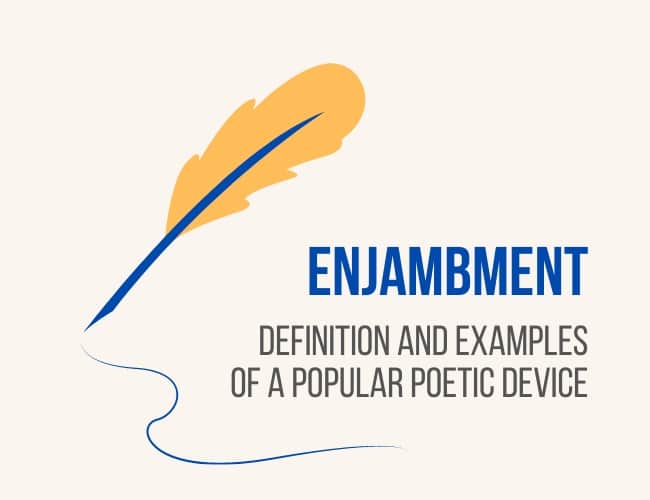The article Enjambment: Definition and Examples for Writers appeared first on The Write Practice.
When you think about the literary devices that poets use, you might think of rhyme scheme or metaphors with double meanings. But poets also use line breaks and punctuation in unusual ways too. Let’s look at one such poetic device called enjambment and then we’ll look at some enjambment examples.
Enjambment Definition
The word enjambment comes from the French enjambement, which means to step over or put legs across.
Enjambment in poetry refers to the practice of running lines of poetry from one to the next without using any kind of punctuation to indicate a stop (periods, commas, etc.). As a technique, poets can use it on just a couple of lines or sustain it for an entire poem, depending on their style and preference.
Enjambment Examples
One classic example of enjambment comes from Robert Frost’s poem “The Road Not Taken.” The opening stanza reads:
“Two roads diverged in a yellow wood,
And sorry I could not travel both
And be one traveler, long I stood
And looked down one as far as I could
To where it bent in the undergrowth;”
Look at the lines in the middle that all begin with “And.” See how the lines are connected, but there is a lack of punctuation. The reader must move from one line to the next without pause. Why does Frost (or any poet) use enjambment this way?
We can’t know for sure, but this sentence, broken into several lines, keeps giving the illusion of closure with the end of the line when it picks up again. The image keeps going (kind of like the road and the traveler’s inability to choose.)
Another example, this from William Shakespeare’s Romeo and Juliet (notice the third and fourth lines):
When he shall die,
Take him and cut him out in little stars,
And he will make the face of heaven so fine
That all the world will be in love with night
And pay no worship to the garish sun.
Enjambment forces the reader’s eye to the next line before they’ve completely processed the thought, creating tension between word and idea. Juliet in this scene is desperate for news from Nurse about Romeo, and the line breaks work with her dramatic description of his affect on the world.
(Shakespeare was also using the breaks to maintain iambic pentameter, the rhythm created by the strict meter of the lines–soemtimes in what’s also known as blank verse. But that’s another article.)
Why use enjambment?
So now that you know what enjambment is, why should you use it? Well, enjambment can help create a certain kind of flow in your poetry. By cutting a thought off without punctuation, it keeps the poem rolling forward and allows ideas to jump over each other. This makes the poem feel more alive and creates an exciting rhythm for readers.
It can also be used to surprise the reader. An idea is presented in the first line of the enjambment, only to be met with a conflicting or contrasting conclusion in the second line. Enjambed lines can also allow for a freer flow of sentences or deas, or continued enforcement of the poem’s main idea without the encumbrance of punctuation that is often deemed optional in poetry anyway.
The Opposite of Enjambment: End-stopped
The opposite of enjambment is end-stopped lines, when a line in a poem ends with a period, comma, or other punctuation mark.
Here’s an example of end-stopped lines from Shakespeare’s Julius Ceasar:
Cowards die many times before their deaths;
The valiant never taste of death but once.
Of all the wonders that I yet have heard,
It seems to me most strange that men should fear;
Seeing that death, a necessary end,
Will come when it will come.
This speech spoken by Julius Caesar stops at the end of each line, creating a harsh, clipped speech. This mirrors his own irritation with the people around him and foreshadows his own end (that is certainly coming sooner than he thinks!)
Now that you’ve seen a number of examples of enjambment, it’s your turn to play with the unexpected beats that a break between lines can create. How might you surprise your reader by breaking an idea in the middle of lines or sentences?
Have you ever written poetry with enjambment? Does your favorite poem use enjambment? Share in the comments.
Need more grammar help? My favorite tool that helps find grammar problems and even generates reports to help improve my writing is ProWritingAid. Works with Word, Scrivener, Google Docs, and web browsers. Also, be sure to use my coupon code to get 20 percent off: WritePractice20
PRACTICE
Write for fifteen minutes using enjambment generously. Split ideas across multiple lines, and add some twists and turns to those ideas. Post your practice in the Pro Practice Workshop here, and leave feedback for a few other writers.
The article Enjambment: Definition and Examples for Writers appeared first on The Write Practice. The Write Practice – The Online Writing Workbook
Go to Source
Author: Liz Bureman
